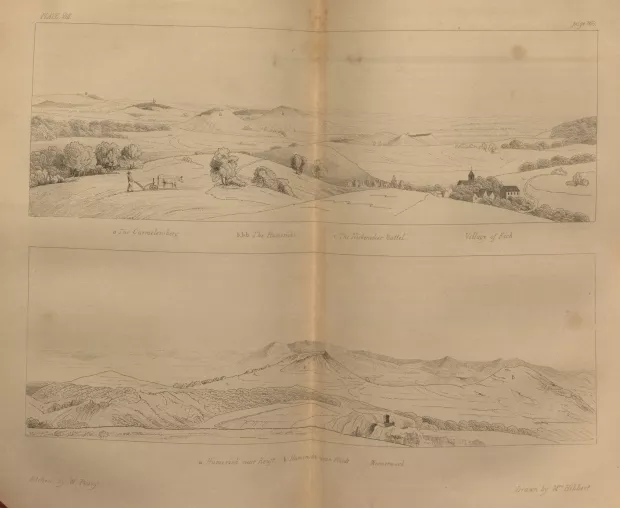Creation Date
1832
Height
21 cm
Width
24 cm
Medium
Genre
Description
This portrayal of the Eifel mountain range further suggests that Romantic culture was developing an increasingly scientific interest in volcanism. The content of the image is neither sublime nor picturesque, yet the book it illustrates—a scientific work concerning the origins of volcanoes—sells very well and is consumed voraciously by the reading public. Hibbert depicts the European landscape in 1832 as shaped by a Laacher See eruption. In the upper left corner, a farmer is plowing his field with the help of a mule. The village of Eich is depicted in the same frame. The lower frame depicts the hills created by the supervolcano. Due to the formation of these hills, streams (like the Nette depicted in the lower portion of this image) are allowed to flow through valleys to sustain life in the surrounding villages.
After studying the Eifel mountain range with her husband Samuel, Charlotte Hibbert-Ware realized that much of the landscape was formed by volcanic activity. She portrayed this countryside as peaceful and picturesque. There are no exploding volcanoes or clouds of smoke which would evoke the sublime. Peaceful portrayals of volcanic landscapes began to emerge after more was discovered concerning volcanoes. Romantic culture began to understand the potential benefits of volcanic activity for the environment, and it is this sense of natural order and peace that pervades this particular image.
Charlotte and Samuel traveled to Germany following their fifth year of marriage to study the Eifel mountain range together. Charlotte etched this image during their journey. The function of the piece is to accompany Samuel’s text in History of Extinct Volcanoes (the title seems ironic as the largest volcano, Laacher See, is not extinct). In this work, Samuel investigates the ways in which the landscape has been shaped by volcanic eruptions.
For his accurate surveys of the Shetland Islands (in which he found vast iron deposits), the Society of Arts awarded Samuel Hibbert-Ware with the Iris Gold Metal. During the early 1820s, Samuel Hibbert-Ware’s reputation as a geologist increased significantly due to this prestigious award. The sell of his book (Survey of the Shetland Islands) financially enabled him to focus on surveying land, and he later performed a survey of Laacher See (D. Hudson, The Royal Society of Arts 84).
The book History of the Extinct Volcanoes with "Plate VIII" was published in 1831 shortly after Charlotte and Samuel Hibbert drew the landscape surrounding Laacher See. A copy of their landscape etching is now owned and available to the public in Memorial Library at the University of Wisconsin—Madison.
Locations Description
Village of Eich
This small, farm-based German municipality is near Laacher See on the left bank of the Rhine River. Within the last two decades, its population was recorded as approximately 3,000 (B. Scharf and S.Bjork Eifel Maar Lakes 12).
Laacher See
This supervolcano in western Germany is characterized by the enormous magma chamber beneath its crater. The chamber is so large that if it were to erupt, the size of the blast would be thousands of times larger than that of Mount Vesuvius’ eruption in 79 AD. Such an eruption would wipe out European civilization, and would perhaps bring about a new ice age by blocking the sun's light with ash. When the Hibbert-Wares surveyed the land around Laacher See, they could not completely understand what they were mapping—Samuel Hibbert-Ware only theorized that Laacher See was a volcano. Even today, the Laacher See has been so little researched that scientists cannot predict if the volcano will erupt tomorrow or millennia from now. Charlotte and Samuel Hibbert-Ware were pioneers in research concerning Laacher See and supervolcanoes in general (B. Scharf and S. Bjork, Eifel Maar Lakes 52-73).
Copyright
Copyright 2009, Memorial Library, University of Wisconsin, Madison
Publisher
W. and H. Laing
Collection
Accession Number
A10966
Additional Information
Bibliography
Benezit, Emmanuel. Dictionary of Artists. Paris: Grund, 2006.
Breining, Greg. Supervolcano: The Ticking Time Bomb. St. Paul, MN: Voyageur P, 2007.
Evans, Joan. A History of the Society of Antiquaries. London: Oxford UP, 1956.
Haswell-Smith, Hamish. The Scottish Islands. Edinburgh: Canongate, 2004.
Hudson, Derek. The Royal Society of Arts, 1754-1954. London: Murray, 1954.
Mayer, Ralph. HarperCollins Dictionary of Art Terms and Techniques. New York, N.Y: HarperPerennial, 1991.
Scharf, Burkhard W., and Sven Björk, eds. Limnology of Eifel Maar Lakes.
Stuttgart: E. Schweitzerbart’sche Verlagsbuchhandlung, 1992.
Sutton, C. W. “Ware, Samuel Hibbert- (1782–1848).” Oxford Dictionary of National Biography.Ed. H. C. G. Matthew and Brian Harrison. Oxford: OUP, 2004. 2 Apr. 2009 http://www.oxforddnb.com/view/article/13197.

